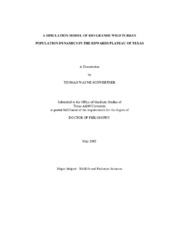| dc.description.abstract | I investigated the effect of precipitation and predator abundance on Rio Grande wild
turkey (Meleagris gallopavo; RGWT) in Texas. My results suggested that RGWT
production was strongly correlated with cumulative winter precipitation over the range
of the RGWT in Texas. However, I found no evidence that predator abundance
influenced RGWT production, although spatial-asynchrony of predator populations at
multiple spatial scales might have masked broad-scale effects. Using the results of these
analyses, as well as empirical data derived from the literature and from field studies in
the southern Edwards Plateau, I developed a stochastic, density-dependent, sex- and agespecific
simulation model of wild turkey population dynamics. I used the model to
evaluate the effect of alternative harvest management strategies on turkey populations.
Sensitivity analysis of the model suggested that shape of the density-dependence
relationship, clutch size, hatchability, juvenile sex ratio, poult survival, juvenile survival,
and nonbreeding hen mortality most strongly influenced model outcome. Of these,
density-dependence, sex ratio, and juvenile survival were least understood and merit
further research. My evaluation of fall hen harvest suggested that current rates do not pose a threat to turkey populations. Moreover, it appears that hen harvest can be
extended to other portions of the RGWT range without reducing turkey abundance,
assuming that population dynamics and harvest rates are similar to those in the current
fall harvest zone. Finally, simulation of alternative hen harvest rates suggested that rates
≥5% of the fall hen population resulted in significant declines in the simulated
population after 25 years, and rates ≥15% resulted in significant risk of extinction to the
simulated population. | en |


